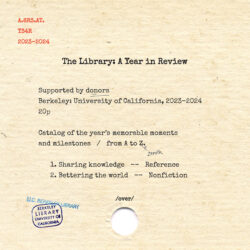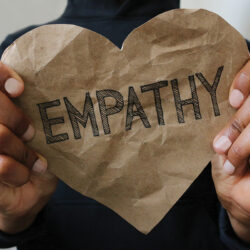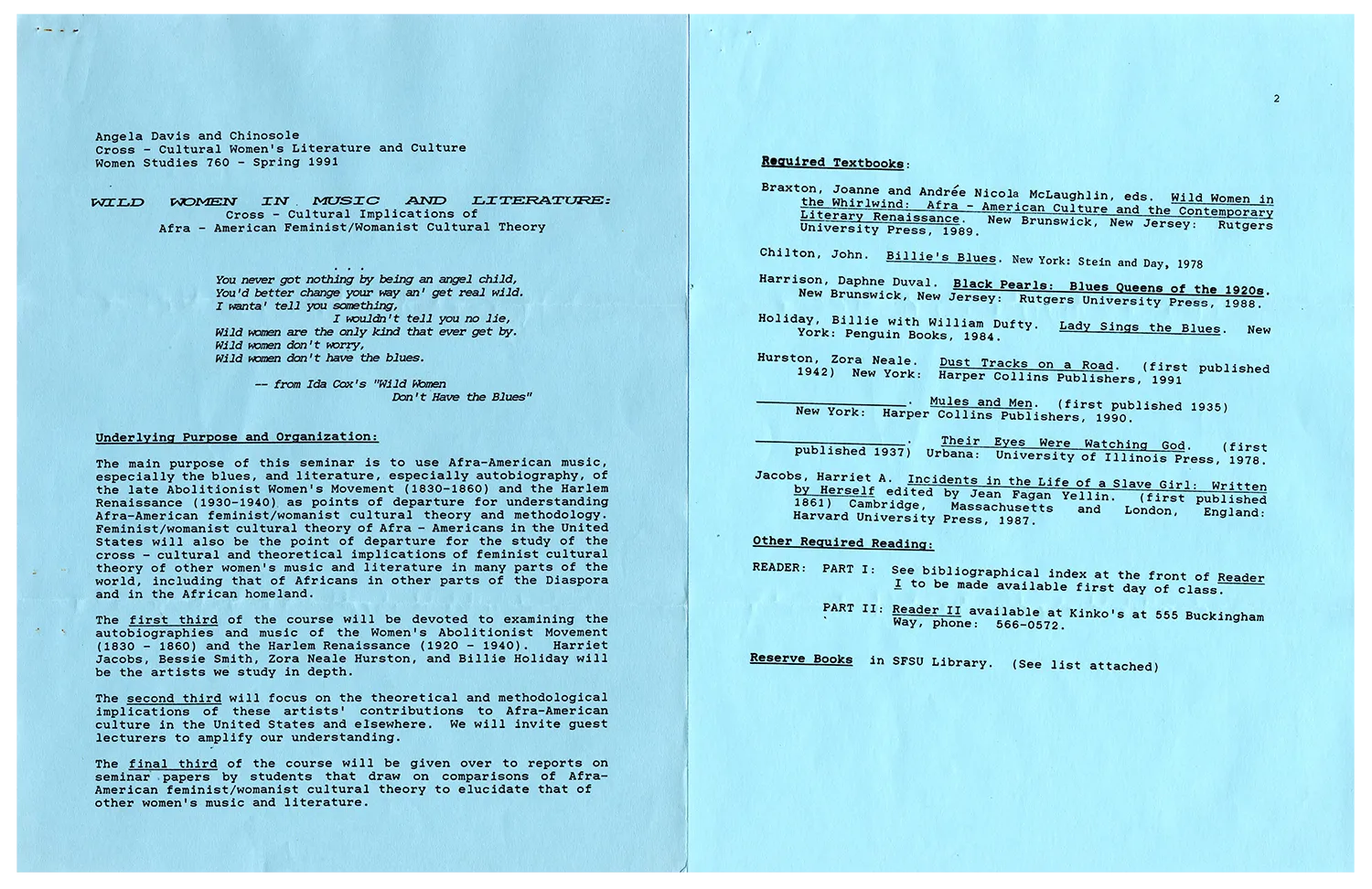
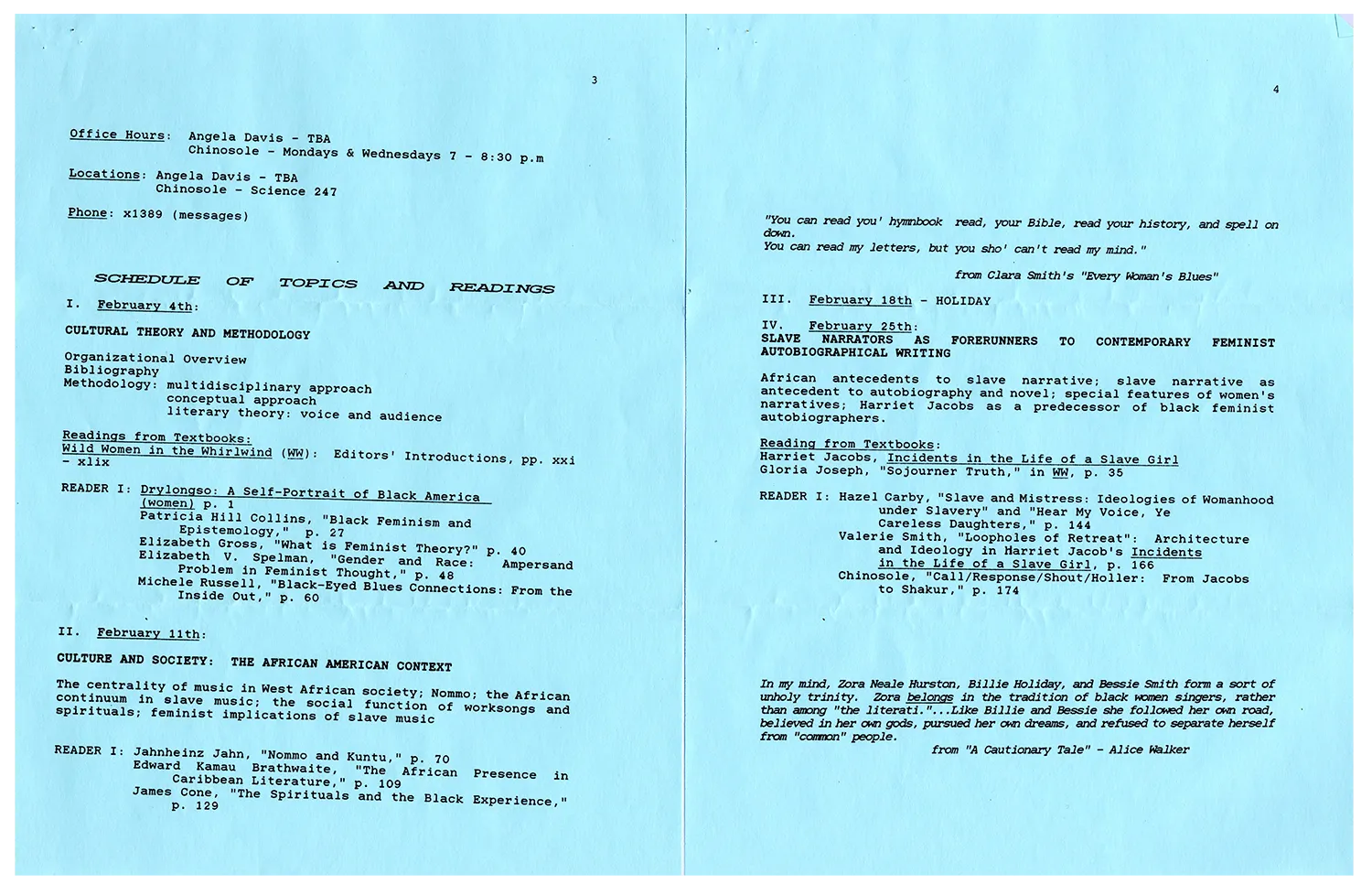
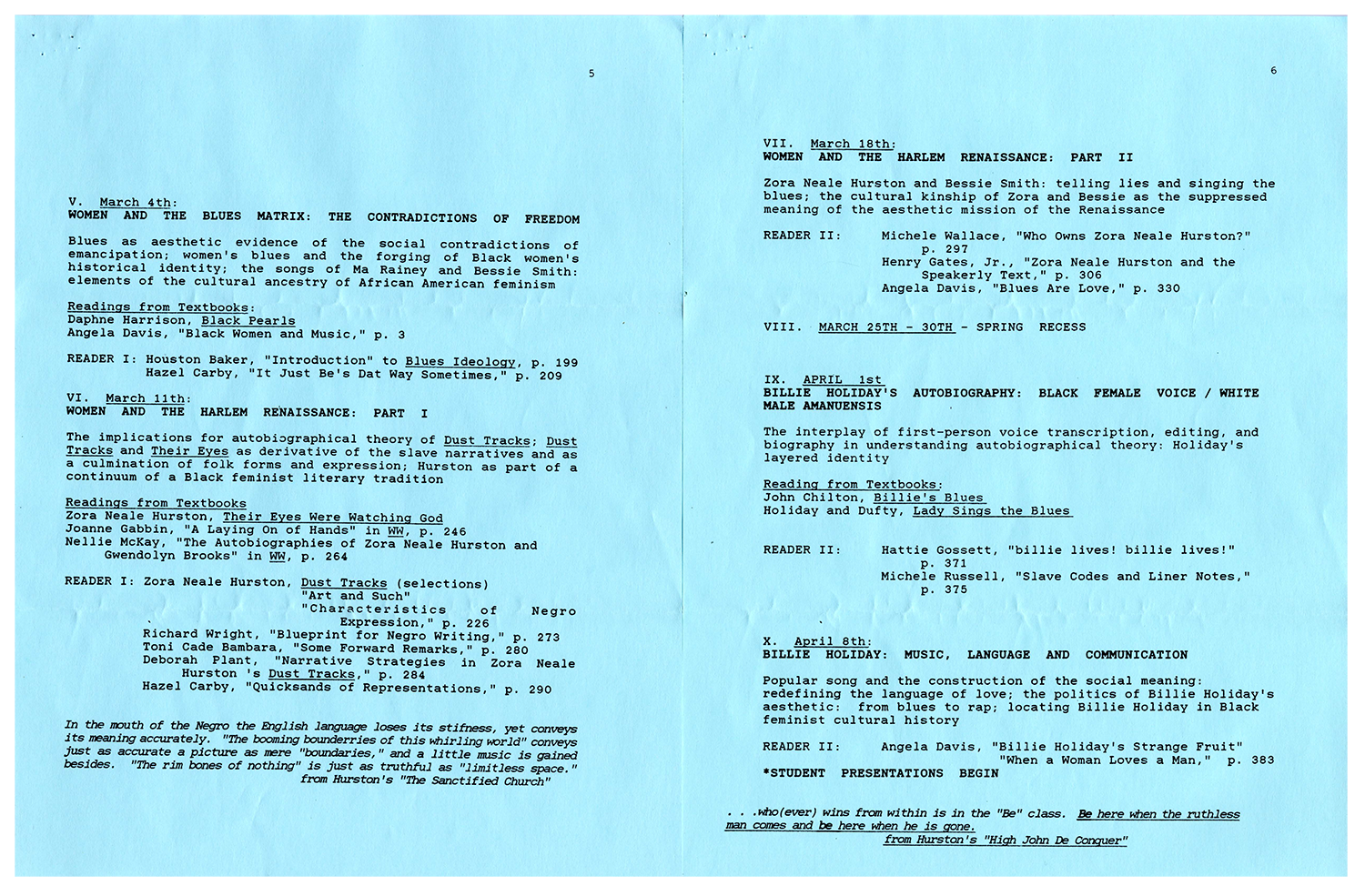
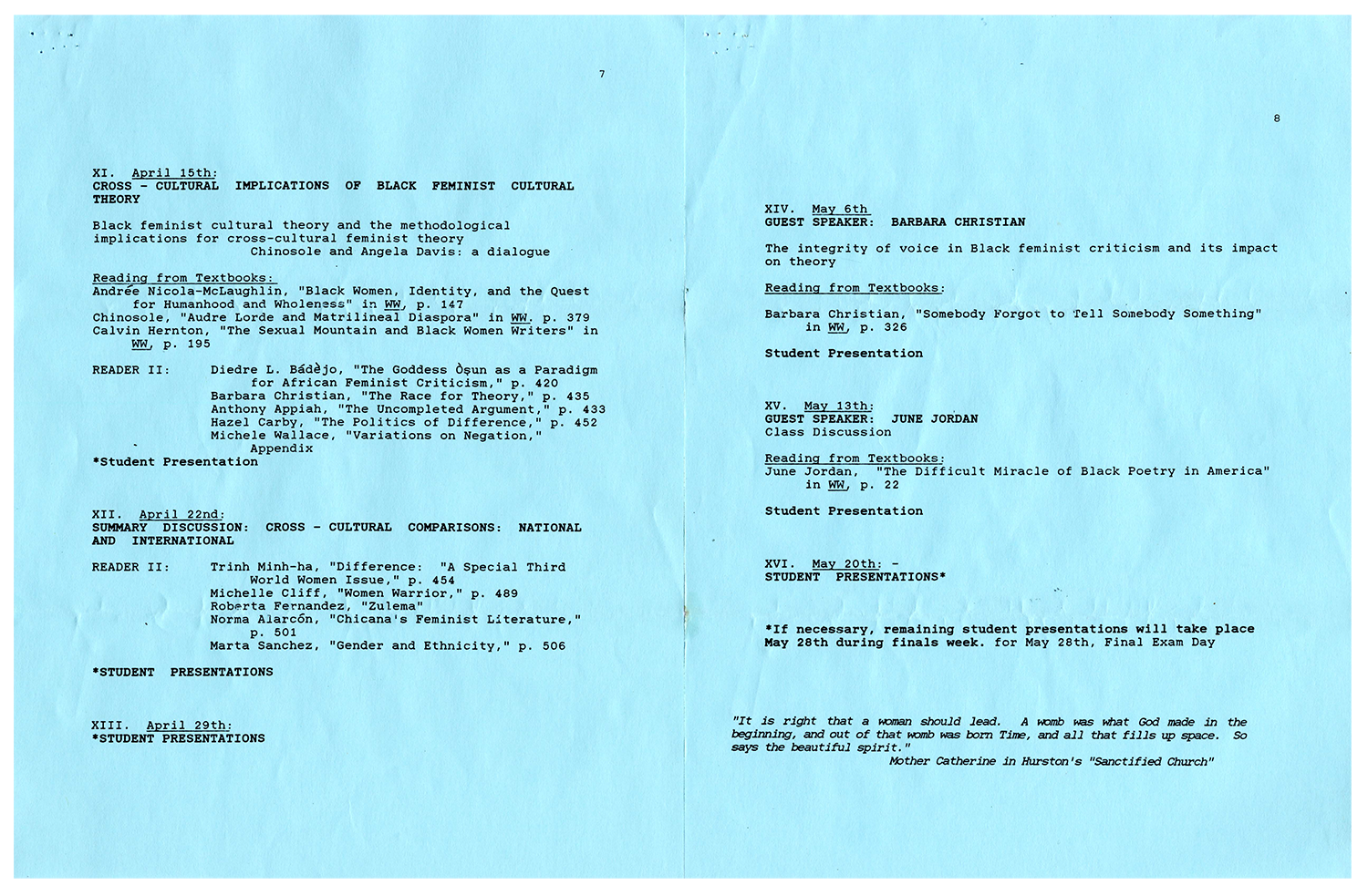
In the spring of 1991, revolutionaries and scholars Angela Davis and Chinosole taught a course at San Francisco State called Wild Women in Music and Literature: Cross-Cultural Implications of Afra-American Feminist/Womanist Cultural Theory. Christian and Jordan were guest speakers in the class.
Angela Davis and Chinosole
Cross – Cultural Women’s Literature and Culture
Women Studies 760 – Spring 1991
Wild Women in Music and Literature:
Cross – Cultural Implications of
Afra – American Feminist/Womanist Cultural Theory
You never got nothing by being an angel child,
You’d better change your way an’ get real wild.
I wanta’ tell you something,
I wouldn’t tell you no lie,
Wild women are the only kind that ever get by.
Wild women don’t worry,
Wild women don’t have the blues.
— from Ida Cox’s “Wild Women Don’t Have the Blues”
Underlying Purpose and Organization:
The main purpose of this seminar is to use Afra-American music, especially the blues, and literature, especially autobiography, of the late Abolitionist Women’s Movement (1830-1860) and the Harlem Renaissance (1930-1940) as points of departure for understanding Afra-American feminist/womanist cultural theory and methodology. Feminist/womanist cultural theory of Afra-Americans in the United States will also be the point of departure for the study of the cross-cultural and theoretical implications of feminist cultural theory of other women’s music and literature in many parts of the world, including that of Africans in other parts of the Diaspora and in the African homeland.
The first third of the course will be devoted to examining the autobiographies and music of the Women’s Abolitionist Movement (1830-1860) and the Harlem Renaissance (1920-1940). Harriet Jacobs, Bessie Smith, Zora Neale Hurston, and Billie Holiday will be the artists we study in depth.
The second third will focus on the theoretical and methodological implications of these artists’ contributions to Afra-American culture in the United States and elsewhere. We will invite guest lecturers to amplify our understanding.
The final third of the course will be given over to reports on seminar papers by students that draw on comparisons of Afra-American feminist/womanist cultural theory to elucidate that of other women’s music and literature.
Required Textbooks:
Braxton, Joanne and Andrée Nicola McLaughlin, eds. Wild Women in the Whirlwind: Afra-American Culture and the Contemporary Literary Renaissance. New Brunswick, New Jersey: Rutgers University Press, 1989.
Chilton, John. Billie’s Blues. New York: Stein and Day, 1978
Harrison, Daphne Duval. Black Pearls: Blues Queen of the 1920s. New Brunswick, New Jersey: Rutgers University Press, 1988.
Holiday, Billie with William Dufty. Lady Sings the Blues. New York: Penguin Books, 1984.
Hurston, Zora Neale. Dust Tracks on a Road. (first published 1942) New York: Harper Collins Publishers, 1991
____________________. Mules and Men. (first published 1935) New York: Harper Collins Publishers, 1990.
____________________. Their Eyes Were Watching God. (first published 1937) Urbana: University of Illinois Press, 1978.
Jacobs, Harriet A. Incidents in the Life of a Slave Girl: Written by Herself edited by Jean Fagan Yellin. (first published 1861) Cambridge, Massachusetts and London, England: Harvard University Press, 1987.
Other Required Reading:
Reader: Part [1]: See bibliographical index at the front of Reader [1] to be made available first day of class.
Part [2]: Reader [2] available at Kinko’s at 555 Buckingham Way, phone: 566-0572.
Reserve Books in SFSU Library. (See list attached)
Office Hours: Angela Davis – TBA
Chinosole – Mondays [and] Wednesdays 7 – 8:30 p.m
Locations: Angela Davis – TBA
Chinosole – Science 247
Phone: x1389 (message)
Schedule of Topics and Readings
[1.] February 4th:Cultural Theory and Methodology
Organizational Overview
Bibliography
Methodology: multidisciplinary approach
conceptual approach
literary theory: voice and audience
Readings from Textbooks:
Wild Women in the Whirlwind (WW): Editors’ Introductions, pp. xxi – xlix
Reader [1]: Drylongso: A Self-Portrait of Black America (women) p. 1
Patricia Hill Collins, “Black Feminism and Epistemology,” p. 27
Elizabeth Gross, “What is Feminist Theory?” p. 40
Elizabeth V. Spelman, “Gender and Race: Ampersand Problem in Feminist Thought,” p. 48
Michele Russell, “Black-Eyed Blues Connections: From the Inside Out,” p. 60
Culture and Society: The African American Context
The centrality of music in West African society; Nommo; the African continuum in slave music; the social function of worksongs and spirituals; feminist implications of slave music
Reader [1]: Jahnheinz Jahn, “Nommo and Kuntu,” p. 70
Edward Kamau Brathwaite, “The African Presence in Caribbean Literature,” p. 109
James Cone, “The Spirituals and the Black Experience,” p. 129
“You can read you’ hymnbook read, your Bible, read your history, and spell on down. You can read my letters, but you sho’ can’t read my mind.”
from Clara Smith’s “Every Woman’s Blues”
[3.] February 18th – Holiday [4.] February 25th:Slave Narrators as Forerunners to Contemporary Feminist Autobiographical Writing
African antecedents to slave narrative; slave narrative as antecedent to autobiography and novel; special features of women’s narratives; Harriet Jacobs as a predecessor of black feminist autobiographers.
Reading from Textbooks:
Harriet Jacobs, Incidents in the Life of a Slave Girl
Gloria Joseph, “Sojourner Truth,” in WW, p. 35
Reader [1]: Hazel Carby, “Slave and Mistress: Ideologies of Womanhood under Slavery” and “Hear My Voice, Ye Careless Daughters,” p. 144
Valerie Smith, “Loopholes of Retreat”: Architecture and Ideology in Harriet Jacob’s Incidents in the Life of a Slave Girl, p. 166
Chinosole, “Call/Response/Shout/Holler: From Jacobs to Shakur,” p. 174
In my mind, Zora Neale Hurston, Billie Holiday, and Bessie Smith form a sort of unholy trinity. Zora belongs in the tradition of black women singers, rather than among “the literati.” … Like Billie and Bessie she followed her own road, believed in her own gods, pursued her own dreams, and refused to separate herself from “common” people.
from “A Cautionary Tale” – Alice Walker
[5.] March 4th:Women and the Blues Matrix: The Contradictions of Freedom
Blues as aesthetic evidence of the social contradictions of emancipation; women’s blues and the forging of Black women’s historical identity; the songs of Ma Rainey and Bessie Smith: elements of the cultural ancestry of African American feminism
Readings from Textbooks:
Daphne Harrison, Black Pearls
Angela Davis, “Black Women and Music,” p. 3
Reader [1]: Houston Baker, “Introduction” to Blues Ideology, p. 199
Hazel Carby, “It Just Be’s Dat Way Sometimes,” p. 209
Women and the Harlem Renaissance: Part [1]
The implications for autobiographical theory of Dust Tracks; Dust Tracks and Their Eyes as derivative of the slave narratives and as a culmination of folk forms and expression; Hurston as part of a continuum of a Black feminist literary tradition
Readings from Textbooks
Zora Neale Hurston, Their Eyes Were Watching God
Joanne Gabbin, “A Laying On of Hands” in WW, p. 246
Nellie McKay, “The Autobiographies of Zora Neale Hurston and Gwendolyn Brooks” in WW, p. 264
Reader [1]: Zora Neale Hurston, Dust Tracks (selections)
“Art and Such”
“Characteristics of Negro Expression,” p. 226
Richard Wright, “Blueprint for Negro Writing,” p. 273
Toni Cade Bambara, “Some Forward Remarks,” p. 280
Deborah Plant, “Narrative Strategies in Zora Neale Hurston’s Dust Tracks,” p. 284
Hazel Carby, “Quicksands of Representations,” p. 290.
In the mouth of the Negro the English language loses its stiffness, yet conveys its meaning accurately. “The booming bounderries of this whirling world” conveys just as accurate a picture as mere “boundaries,” and a little music is gained besides. “The rim bones of nothing” is just as truthful as “limitless space.”
from Hurston’s “The Sanctified Church”
Women and the Harlem Renaissance: Part [2]
Zora Neale Hurston and Bessie Smith: telling lies and singing the blues; the cultural kinship of Zora and Bessie as the suppressed meaning of the aesthetic mission of the Renaissance
Reader [2]: Michele Wallace, “Who Owns Zora Neale Hurston?” p. 297
Henry Gates, Jr., “Zora Neale Hurston and the Speakerly Text,” p. 306
Angela Davis, “Blues Are Love,” p. 330.
Billie Holiday’s Autobiography: Black Female Voice / White Male Amanuensis
The interplay of first-person voice transcription, editing, and biography in understanding autobiographical theory: Holiday’s layered identity
Reading from Textbooks:
John Chilton, Billie Blues
Holiday and Dufty, Lady Sings the Blues
Reader [2]: Hattie Gossett, “billie lives! billie lives!” p. 371
Michele Russell, “Slave Codes and Liner Notes,” p. 375
Billie Holiday: Music, Language and Communication
Popular song and the construction of the social meaning: redefining the language of love; the politics of Billie Holiday’s aesthetic: from blues to rap; locating Billie Holiday in Black feminist cultural history
Reader [2]: Angela Davis, “Billie Holiday’s Strange Fruit”
“When a Woman Loves a Man,” p. 383
*Student Presentations Begin
… who(ever) wins from within is in the “Be” class. Be here when the ruthless man comes and be here when he is gone.
from Hurston’s “High John De Conquer”
Cross – Cultural Implications of Black Feminist Cultural Theory
Black feminist cultural theory and the methodological implications for cross-cultural feminist theory
Chinosole and Angela Davis: a dialogue
Reading from Textbooks:
Andrée Nicola-McLaughlin, “Black Women, Identity, and the Quest for Humanhood and Wholeness” in WW, p. 147
Chinosole, “Audre Lorde and Matrilineal Diaspora” in WW. p. 379
Calvin Hernton, “The Sexual Mountain and Black Women Writers” in WW, p. 195
Reader [2]: Diedre L. Bádèjo, “The Goddess Òṣun as a Paradigm for African Feminist Criticism,” p. 420
Barbara Christian, “The Race for Theory,” p. 435
Anthony Appiah, “The Uncompleted Argument,” p. 433
Michele Wallace, “Variations on Negation,” Appendix.
*Student Presentation
Summary Discussion: Cross – Cultural Comparisons: National and International
Reader [2]: Trinh Minh-ha, “Difference: “A Special Third World Women Issue,” p. 454
Michelle Cliff, “Women Warrior,” p. 489
Roberta Fernandez, “Zulema”
Norma Alarcón, “Chicana’s Feminist Literature,” p. 501
Marta Sanchez, “Gender and Ethnicity,” p. 506
*Student Presentations
[13.] April 29th:*Student Presentations [14.] May 6th
Guest Speaker: Barbara Christian
The integrity of voice in Black feminist criticism and its impact on theory
Reading from Textbooks:
Barbara Christian, “Somebody Forgot to Tell Somebody Something” in WW, p. 326
Student Presentation
[15.] May 13th:Guest Speaker: June Jordan
Class Discussion
Reading from Textbooks:
June Jordan, “The Difficult Miracle of Black Poetry in America” in WW, p. 22
Student Presentation
[16.] May 20th: –Student Presentations*
*If necessary, remaining student presentations will take place May 28th during finals week. for May 28th, Final Exam Day
“It is right that a woman should lead. A womb was what God made in the beginning, and out of that womb was born Time, and all that fills up space. So says the beautiful spirit.”
Mother Catherine in Hurston’s “Sanctified Church”
Syllabus, Wild Women in Music and Literature, taught by Angela Davis and Chinosole, Spring 1991, Carton 3:13, Barbara Christian papers, BANC MSS 2003/199 c, The Bancroft Library, University of California, Berkeley.



